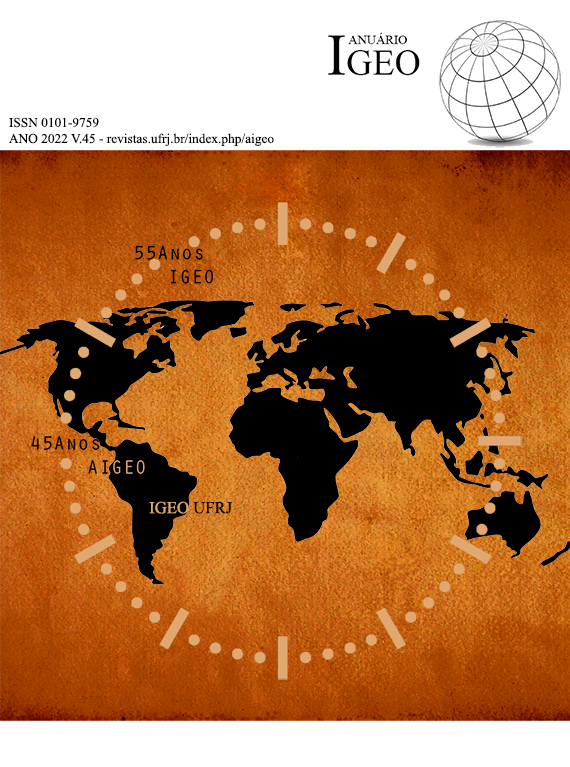Assessment of Land Use and Land Cover Change from 2000 to 2019 in East Java Indonesia
DOI:
https://doi.org/10.11137/1982-3908_2022_45_46456Keywords:
Land use, Land cover, Change, RBI, Landsat-8, East JavaAbstract
This study aims to analyse land use, and land cover (LULC) changes in East Java province in Indonesia. The changes are analysed by comparing two maps (the national digital map and the map interpreted from Landsat-8). Supervised classification of Landsat image using maximum likelihood algorithm done an overall and kappa accuracy of 96.62% and 96.02 %, respectively. The classification produces nine (9) classes, i.e.: (1) the pavement or urban area, (2) heterogeneous agricultural land, (3) paddy field, (4) open water, (5) dense vegetation (forest), (6) sparse vegetation (plantation), (7) shrubland, (8) Wetlands, and (9) Sandy-clay-rock. Furthermore, three subsets areas are explored to study the LULC changes caused by the development of the transportation infrastructure; industrial sites; the agricultural sector; tourism; urbanisation and sub-urbanisation. The LULC change is more marked in the most urbanised areas (in and around the big cities), followed by LULC change in and around medium cities and rural areas. Regional development during the last two decades has increased built-up and plantation areas. Conversely, the development has reduced paddy fields, rural areas, and water bodies. The LULC changes have significantly changed the natural to a human-dominated landscape.
Downloads
References
Ahmed, I.M. & Alla, E.M.A. 2019, 'Landuse impact on the environment of Tuti Island, Sudan', Geography, Environment, Sustainability, vol. 12, no. 3, pp. 27–33. https://doi.org/10.24057/2071-9388-2018-13.
Badan Informasi Geospatial 2018, Peta Rupa Bumi Indonesia Skala 1:25.000.
BIG - see Badan Informasi Geospatial.
BPS Jawa Timur 2017, Provinsi Jawa Timur dalam Angka. Jawa Timur Province in Figures 2017, Badan Pusat Statistik Provinsi Jawa Timur.
BSN 2014, Standar Nasional Indonesia (SNI) 7645:2014 tentang Klasifikasi Penutup Lahan, p. 28.
Congedo, L. 2016, ‘Semi-Automatic Classification Plugin Documentation’. http://dx.doi.org/10.13140/RG.2.2.29474.02242/1
Dastgerdi, A.S., Sargolini, M., Pierantoni, I. & Stimilli, F. 2020, 'Toward an Innovative Strategic Approach for Sustainable Management of Natural Protected Areas in Italy', Geography, Environment, Sustainability, vol. 13, no. 3, pp. 68-75.
https://doi.org/10.24057/2071-9388-2019-143
Elias, E., Seifu, W., Tesfaye, B. & Girmay, W. 2019, 'Impact of land use/cover changes on lake ecosystem of Ethiopia central rift valley', M. Tejada Moral (ed.), Cogent Food & Agriculture, vol. 5, no. 1, p. 1595876. http://dx.doi.org/10.1080/23311932.2019.1595876
Fonji, S.F. & Taff, G.N. 2014, 'Using satellite data to monitor land-use land-cover change in North-eastern Latvia', SpringerPlus, vol. 3, no. 1, pp. 1–15. http://dx.doi.org/10.1186/2193-1801-3-61
Foody, G. 2008, 'Harshness in image classification accuracy assessment', International Journal of Remote Sensing, vol. 29, no. 11, pp. 3137–58. https://doi.org/10.1080/01431160701442120
Foody, G.M. 2004, 'Thematic map comparison: Evaluating the statistical significance of differences in classification accuracy', Photogrammetric Engineering and Remote Sensing, American Society for Photogrammetry and Remote Sensing, pp. 627–33. http://dx.doi.org/10.14358/PERS.70.5.627
Hassen, E.E. & Assen, M. 2018, 'Land use/cover dynamics and its drivers in Gelda catchment, Lake Tana watershed, Ethiopia', Environmental Systems Research, vol. 6, no. 1. https://doi.org/10.1186/s40068-017-0081-x
Klimanova, O., Naumov, A., Greenfieldt, Y., Prado, R.B. & Tretyachenko, D. 2017, 'Recent regional trends of land use and land cover transformations in Brazil', Geography, Environment, Sustainability, vol. 10, no. 4, pp. 98–116. https://doi.org/10.24057/2071-9388-2017-10-4-98-116
Klyuev, N.N. 2019, 'The spatial analyses of natural resources use in Russia for 1990-2017', Geography, Environment, Sustainability, vol. 12, no. 4, pp. 203–11. https://doi.org/10.24057/2071-9388-2018-65
Landgrebe, D. 2015, MultiSpec Tutorial: Supervised Classification-Select Training Fields.
Landgrebe, D. & Biehl, L. 2018, MultiSpec (C), School of Electrical and Computer Engineering Purdue University.
Łucka, D. 2018, 'How to build a community. New Urbanism and its critics', Urban Development Issues, vol. 59, no. 1, pp. 17–26. http://dx.doi.org/10.2478/udi-2018-0025
Mangmeechai, A. 2020, 'Effects of rubber plantation policy on water resources and land-use change in the Northeastern region of Thailand', Geography, Environment, Sustainability, vol. 13, no. 2, pp. 73–83. https://doi.org/10.24057/2071-9388-2019-145
Mtibaa, S. & Irie, M. 2016, 'Land cover mapping in cropland dominated area using information on vegetation phenology and multi-seasonal Landsat 8 images', Euro-Mediterranean Journal for Environmental Integration, vol. 1, no. 1. http://dx.doi.org/10.1007/s41207-016-0006-5
Nguyen, L.B. 2020, 'Land cover change detection in northwestern Vietnam using Landsat images and Google Earth Engine', Journal of Water and Land Development, no. 46, pp. 162–9. http://dx.doi.org/10.24425/jwld.2020.134209
Ptak, M. & Ławniczak, A.E. 2012, ‘Changes in land use in the buffer zone of lake of the Mała Wełna catchment’, Limnological Review, vol. 12, no. 1, pp. 35–44. https://doi.org/https://doi.org/10.2478/v10194-011-0043-z
QGIS Development Team 2019, QGIS Geographic Information System. Open Source Geospatial Foundation Project.
USGS - see United States Geological Survey.
United States Geological Survey 2018, EarthExplorer - Home, viewed <https://earthexplorer.usgs.gov/>.
United States Geological Survey 2019, Landsat Levels of Processing, viewed <https://www.usgs.gov/land-resources/nli/landsat/landsat-levels-processing>.
Downloads
Published
How to Cite
Issue
Section
License
This journal is licensed under a Creative Commons — Attribution 4.0 International — CC BY 4.0, which permits use, distribution and reproduction in any medium, provided the original work is properly cited.















